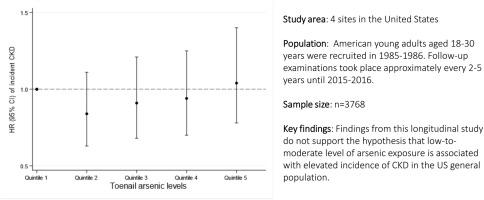Journal of Trace Elements in Medicine and Biology ( IF 3.5 ) Pub Date : 2020-09-28 , DOI: 10.1016/j.jtemb.2020.126657 Kefeng Yang 1 , Cheng Chen 2 , John Brockman 3 , James M Shikany 4 , Ka He 2

|
Background
It is unclear whether arsenic exerts adverse health effects on the kidney at low- and moderate- levels of exposure. We prospectively examined toenail arsenic concentrations measured during young adulthood in relation to incidence of chronic kidney disease (CKD) in midlife.
Methods
A total of 3768 participants (53 % female and 48 % blacks) in the Coronary Artery Risk Development in Young Adults (CARDIA) study were included. Arsenic concentration in toenail clippings was assessed by using inductively coupled plasma mass spectrometry at CARDIA exam year 2. Incident CKD was identified if having estimated glomerular filtration rate <60 mL/min per 1.73 m² or albuminuria >30 mg/g. The association between toenail arsenic levels and CKD incidence over a mean of 24 years of follow-up was examined using multivariable-adjusted Cox proportional hazards models.
Results
After controlling for potential confounders, including demographics, socioeconomics, lifestyle factors, clinical measurements of blood pressure, lipids, and glucose, and medical history, arsenic exposure measured in toenails was not associated with CKD incidence (quintile 5 versus quintile 1: hazard ratio = 1.04, 95 % confidence interval = 0.78–1.40, P for trend = 0.38).
Conclusion
The null association was not modified by sex or race. This longitudinal study does not support the hypothesis that low- and moderate- levels of arsenic exposure are associated with elevated incidence of CKD in the US general population. Further studies are need to investigate species of arsenic biomarkers in relation to nephrotoxicity.
中文翻译:

青年时期低和中等水平的砷暴露和慢性肾病的发病率:来自 CARDIA 微量元素研究的结果
背景
目前尚不清楚砷在低和中等暴露水平下是否会对肾脏产生不利的健康影响。我们前瞻性地研究了在青年期测量的脚趾甲砷浓度与中年慢性肾病 (CKD) 发病率的关系。
方法
青年冠状动脉风险发展 (CARDIA) 研究共包括 3768 名参与者(53% 女性和 48% 黑人)。在 CARDIA 考试第 2 年使用电感耦合等离子体质谱法评估脚趾甲剪下的砷浓度。如果估计肾小球滤过率 <60 mL/min/1.73 m² 或蛋白尿 >30 mg/g,则确定为 CKD。使用多变量调整的 Cox 比例风险模型检查了平均 24 年随访期间脚趾甲砷水平与 CKD 发病率之间的关联。
结果
在控制了潜在的混杂因素,包括人口统计学、社会经济学、生活方式因素、血压、血脂和血糖的临床测量值以及病史后,脚趾甲中测量的砷暴露与 CKD 发病率无关(五分位 5 与五分位 1:风险比 = 1.04,95% 置信区间 = 0.78–1.40,趋势P = 0.38)。
结论
零关联未因性别或种族而改变。该纵向研究不支持低和中等水平砷暴露与美国普通人群 CKD 发病率升高相关的假设。需要进一步研究与肾毒性相关的砷生物标志物种类。


























 京公网安备 11010802027423号
京公网安备 11010802027423号